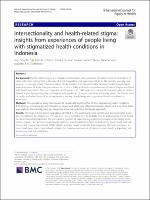Human resources for health: task shifting to promote basic health service delivery among internally displaced people in ethnic health program service areas in eastern Burma/Myanmar
| Low, Sharon
Tun, Kyaw Thura Mhote, Naw Pue Pue Htoo, Saw Nay Maung, Cynthia Kyaw, Saw Win Oo, Saw Eh Kalu Shwe Pocock, Nicola Suyin |
|
| 2014-09-29 | |
|
Background: Burma/Myanmar was controlled by a military regime for over 50 years. Many basic social and protection services have been neglected, specifically in the ethnic areas. Development in these areas was led by the ethnic non-state actors to ensure care and the availability of health services for the communities living in the border ethnic-controlled areas. Political changes in Burma/Myanmar have been ongoing since the end of 2010. Given the ethnic diversity of Burma/Myanmar, many challenges in ensuring health service coverage among all ethnic groups lie ahead. Methods: A case study method was used to document how existing human resources for health (HRH) reach the vulnerable population in the ethnic health organizations’ (EHOs) and community-based organizations’ (CBHOs) service areas, and their related information on training and services delivered. Mixed methods were used. Survey data on HRH, service provision, and training were collected from clinic-in-charges in 110 clinics in 14 Karen/Kayin townships through a rapid-mapping exercise. We also reviewed 7 organizational and policy documents and conducted 10 interviews and discussions with clinic-in-charges. Findings: Despite the lack of skilled medical professionals, the EHOs and CBHOs have been serving the population along the border through task shifting to less specialized health workers. Clinics and mobile teams work in partnership, focusing on primary care with some aspects of secondary care. The rapid-mapping exercise showed that the aggregate HRH density in Karen/Kayin state is 2.8 per 1,000 population. Every mobile team has 1.8 health workers per 1,000 population, whereas each clinic has between 2.5 and 3.9 health workers per 1,000 population. By reorganizing and training the workforce with a rigorous and up-to-date curriculum, EHOs and CBHOs present a viable solution for improving health service coverage to the underserved population. Conclusion: Despite the chronic conflict in Burma/Myanmar, this report provides evidence of the substantive system of health care provision and access in the Karen/Kayin State over the past 20 years. It underscores the climate of vulnerability of the EHOs and CBHOs due to lack of regional and international understanding of the political complexities in Burma/Myanmar. As Association of Southeast Asian Nations (ASEAN) integration gathers pace, this case study highlights potential issues relating to migration and health access. The case also documents the challenge of integrating indigenous and/or cross-border health systems, with the ongoing risk of deepening ethnic conflicts in Burma/Myanmar as the peace process is negotiated. |
|
| health system strengthening
health workforce task shifting internally displaced people Burma/Myanmar |
|
| Journal | |
| Text | |
| application/pdf | |
| This work is licensed under a Creative Commons Attribution 4.0 International license (CC BY 4.0). | |
| Open access | |
| Copyright (c) 2014 Sharon Low et al. | |
| https://resources.equityinitiative.org/handle/ei/559 |
This item appears in the following Collection(s) |
|
|
Collections
|
Related items
Showing items related by title, author, creator and subject.
-
Can mHealth and eHealth improve management of diabetes and hypertension in a hard-to-reach population? —lessons learned from a process evaluation of digital health to support a peer educator model in Cambodia using the RE-AIM framework
Steinman, Lesley; Pelt, Maurits van; Hen, Heang; Chhea, Chhorvann; Lan, Channe Suy; Te, Vannarath; LoGerfo, James; Fitzpatrick, Annette L. (2020-10-05)
Background: The burden of non-communicable diseases (NCDs) is increasing in low- and middle-income countries (LMICs) where NCDs cause 4:5 deaths, disproportionately affect poorer populations, and carry a large economic burden. Digital interventions can improve NCD management for these hard-to-reach populations with inadequate health systems and high cell-phone coverage; however, there is limited research on whether digital health is reaching this potential. We conducted a process evaluation to understand challenges and successes from a digital ... -
Intersectionality and health-related stigma: insights from experiences of people living with stigmatized health conditions in Indonesia
Rai, Sarju Sing; Peters, Ruth M. H.; Syurina, Elena V.; Irwanto, Irwanto; Naniche, Denise; Zweekhorst, Marjolein B. M. (International Journal for Equity in Health, 2020-12)
Abstract Background Health-related stigma is a complex phenomenon, the experience of which intersects with those of other adversities arising from a diversity of social inequalities and oppressive identities like gender, sexuality, and poverty – a concept called “intersectionality”. Understanding this intersectionality between health-related stigma and other forms of social marginalization can provide a fuller and more comprehensive picture of stigma associated with health conditions. The main objective ... -
Perspectives on health equity and social determinants of health
Bogard, Kimber; Murry, Velma McBride; Alexander, Charlee M.; National Academy of Medicine (U.S.) (National Academy Of Medicine, 2017)
Social factors, signals, and biases shape the health of our nation. Racism and poverty manifest in unequal social, environmental, and economic conditions, resulting in deep-rooted health disparities that carry over from generation to generation. In Perspectives on Health Equity and Social Determinants of Health, authors call for collective action across sectors to reverse the debilitating and often lethal consequences of health inequity. This edited volume of discussion papers provides recommendations to advance the agenda to promote health ...



